Note: Yale School of the Environment (YSE) was formerly known as the Yale School of Forestry & Environmental Studies (F&ES). News articles and events posted prior to July 1, 2020 refer to the School's name at that time.
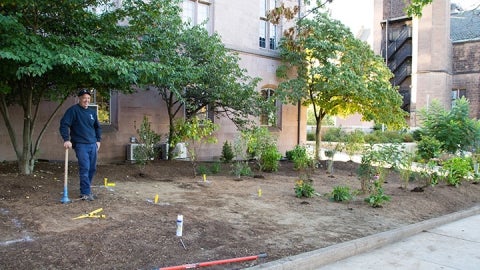 A new rain garden outside Sage Hall is being constructed by Ray McCarthy, above, Michael Sullivan, and Ronnie Brown, members of the Yale Office of Facilities.
A new rain garden outside Sage Hall is being constructed by Ray McCarthy, above, Michael Sullivan, and Ronnie Brown, members of the Yale Office of Facilities.
A year ago, two F&ES students worked with the city of New Haven to develop new standards to promote “green infrastructure” that might better handle storm water runoff across the city. But getting an actual project in the ground was proving difficult.
So they decided to look even closer to home: Sage Hall, the iconic 90-year-old building and longtime flagship of the School.
“We wanted to find a place to test some of the skills and knowledge we’d gotten through that independent study,” said Cary Simmons ’15 M.E.M., who at the time was working with Caitlin Feehan ’14 M.E.M.
“Then one day we were walking out of a meeting, and we looked at Sage Hall. We thought, it’s such an underutilized piece of property in this part of campus. And after studying the Yale stormwater plan [part of the university’s larger sustainability planning plan], we learned that the downspout on Sage is one of the higher priorities on the list to be disconnected on campus.”
So the students came up with a plan. They suggested that the School build a rain garden — which uses berms and native plants to collect and absorb rainwater — to replace an old drainage system that simply dumped stormwater from the roof of Sage into the city’s sewers. The plan was endorsed by F&ES Dean Peter Crane and university officials.
And this week, a Yale Office of Facilities crew began construction of the project, which was designed by Simmons and Feehan (who now works on green infrastructure for the District of Columbia Water and Sewer Authority).
By Tuesday afternoon, the Facilities team had completed the berms that will keep up to 1 ½ feet of storm water from running onto Prospect Street. And they started planting local plant species — including hydrangeas, swamp azaleas, and buttonbush — that are capable of surviving heavy rain events but can also withstand long periods of dry weather.
By the end of the week, they will install a mulch bed, ground cover, and additional plants – as well as a red oak bench from Yale Myers Forest.
According to officials, the university-funded project is expected to divert 300 to 500 gallons of stormwater from the sewer systems during heavy storm events.
Beyond the ecological and water management benefits, the rain garden has offered a very practical application of lessons taught in the classroom, says Brad Gentry, a professor at F&ES whose course in ecosystem services (F&ES 963) helped inspire the project.
“Most of our Master’s students want to come in, hone some skills, and then go out and manage some resource system,” he said. “And they need a solid grounding in theory in order to do that. But they also need practice in making real projects happen.
“This kind of project is a great opportunity to get that. The students need to have the idea and the design, but they also need to know how to organize the money, and the political support, and the operational support to make it happen.”
The project has also helped promote the implementation of green design into how Yale manages its properties and reflects increased integration between academic research and operational practices on campus, Gentry said.
For the Yale Office of Facilities, such projects enable staff to engage more with students and faculty, and incorporate the lessons from the classroom into the work they do, agreed Walter Debboli, a supervisor of grounds maintenance who has overseen the Sage project.
“You get a better idea for what is happening in other parts of Yale,” he said. “And it gives everybody a little more enthusiasm about what they do.”
So they decided to look even closer to home: Sage Hall, the iconic 90-year-old building and longtime flagship of the School.
“We wanted to find a place to test some of the skills and knowledge we’d gotten through that independent study,” said Cary Simmons ’15 M.E.M., who at the time was working with Caitlin Feehan ’14 M.E.M.
“Then one day we were walking out of a meeting, and we looked at Sage Hall. We thought, it’s such an underutilized piece of property in this part of campus. And after studying the Yale stormwater plan [part of the university’s larger sustainability planning plan], we learned that the downspout on Sage is one of the higher priorities on the list to be disconnected on campus.”
So the students came up with a plan. They suggested that the School build a rain garden — which uses berms and native plants to collect and absorb rainwater — to replace an old drainage system that simply dumped stormwater from the roof of Sage into the city’s sewers. The plan was endorsed by F&ES Dean Peter Crane and university officials.
And this week, a Yale Office of Facilities crew began construction of the project, which was designed by Simmons and Feehan (who now works on green infrastructure for the District of Columbia Water and Sewer Authority).
By Tuesday afternoon, the Facilities team had completed the berms that will keep up to 1 ½ feet of storm water from running onto Prospect Street. And they started planting local plant species — including hydrangeas, swamp azaleas, and buttonbush — that are capable of surviving heavy rain events but can also withstand long periods of dry weather.
By the end of the week, they will install a mulch bed, ground cover, and additional plants – as well as a red oak bench from Yale Myers Forest.
According to officials, the university-funded project is expected to divert 300 to 500 gallons of stormwater from the sewer systems during heavy storm events.
Beyond the ecological and water management benefits, the rain garden has offered a very practical application of lessons taught in the classroom, says Brad Gentry, a professor at F&ES whose course in ecosystem services (F&ES 963) helped inspire the project.
“Most of our Master’s students want to come in, hone some skills, and then go out and manage some resource system,” he said. “And they need a solid grounding in theory in order to do that. But they also need practice in making real projects happen.
“This kind of project is a great opportunity to get that. The students need to have the idea and the design, but they also need to know how to organize the money, and the political support, and the operational support to make it happen.”
The project has also helped promote the implementation of green design into how Yale manages its properties and reflects increased integration between academic research and operational practices on campus, Gentry said.
For the Yale Office of Facilities, such projects enable staff to engage more with students and faculty, and incorporate the lessons from the classroom into the work they do, agreed Walter Debboli, a supervisor of grounds maintenance who has overseen the Sage project.
“You get a better idea for what is happening in other parts of Yale,” he said. “And it gives everybody a little more enthusiasm about what they do.”
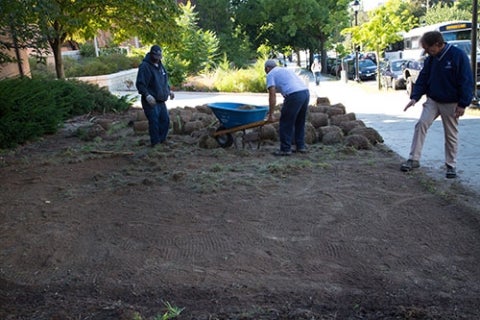 <p class="p1"> On the first day of the project, a team of workers from the Yale Office of Facilities — including Michael Sullivan and Ronnie Brown — stripped sod, removed plants from along the edge of the building, excavated a basin to contain stormwater, and began forming berms. Walter Debboli is on the far right.</p>
<p class="p1"> On the first day of the project, a team of workers from the Yale Office of Facilities — including Michael Sullivan and Ronnie Brown — stripped sod, removed plants from along the edge of the building, excavated a basin to contain stormwater, and began forming berms. Walter Debboli is on the far right.</p>
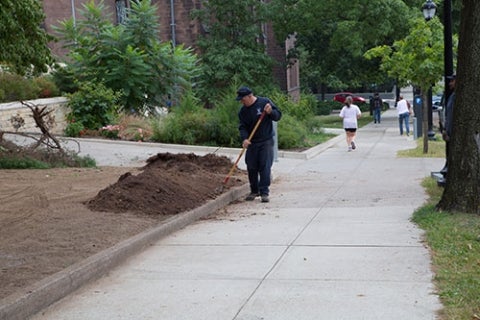 <p class="p1"> Workers continued to shape the berms and began adding plants on Day 2. </p>
<p class="p1"> Workers continued to shape the berms and began adding plants on Day 2. </p>
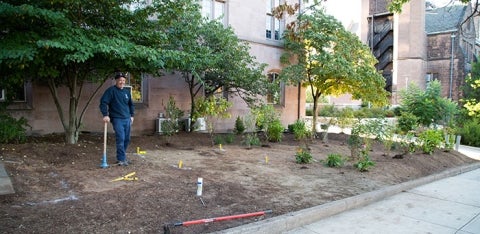 <p class="p1"> On Day 3, Ray McCarthy of the Yale Office of Facilities stands in the garden, which now contained many of the new plants. The project called for the use of native species — including hydrangeas, swamp azaleas, and buttonbush — that are capable of surviving heavy rain events but can also withstand long periods of dry weather.</p>
<p class="p1"> On Day 3, Ray McCarthy of the Yale Office of Facilities stands in the garden, which now contained many of the new plants. The project called for the use of native species — including hydrangeas, swamp azaleas, and buttonbush — that are capable of surviving heavy rain events but can also withstand long periods of dry weather.</p>
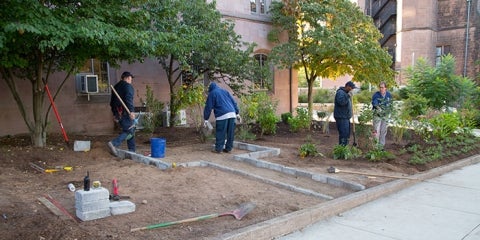 <p class="p1"> Workers continued planting on Day 4, and inserted a stone walkway for a sitting area. Eventually, that area will feature a bench made of red oak from the Yale Myers Forest.</p>
<p class="p1"> Workers continued planting on Day 4, and inserted a stone walkway for a sitting area. Eventually, that area will feature a bench made of red oak from the Yale Myers Forest.</p>
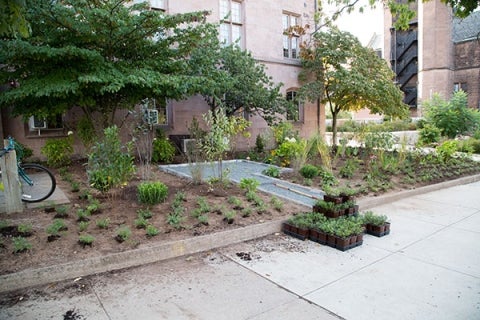 Rain garden with additional plants and walkway.
Rain garden with additional plants and walkway.
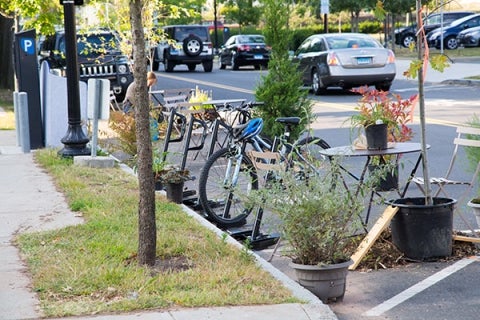 New bike parking and sitting area across from rain garden
New bike parking and sitting area across from rain garden
– Kevin Dennehy kevin.dennehy@yale.edu 203 436-4842
Published
September 17, 2014